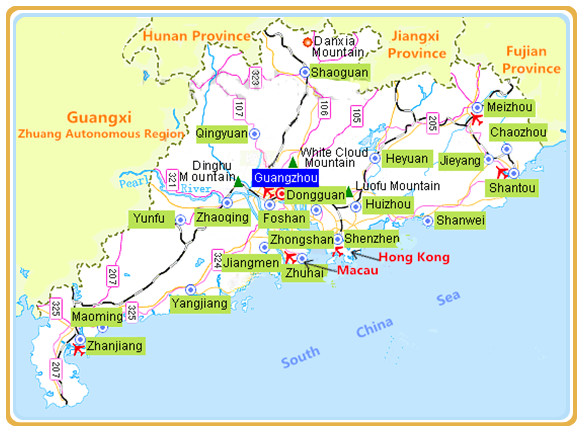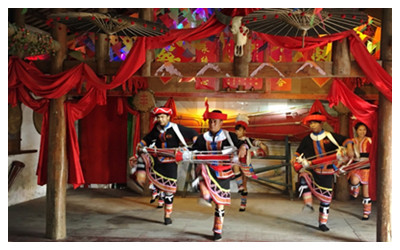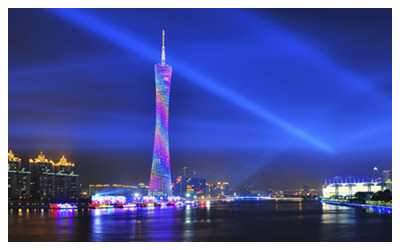Skype: neodalle-travel
Tel: +86 135 7447 2266
E-mail: sales@zhangjiajieholiday.com
 Situated in the southernmost part of China's mainland, Guangdong Province covers a land area of 179,800 square kilometers, an island area of about 1,592 square kilometers and has 3,368 kilometers of winding coastline, which is the longest in the country. Rivers from all over the province discharge into the South China Sea, forming the fertile Pearl River Delta, which is one of the countries' most densely cultivated areas. Its capital city, Guangzhou, formerly known as Canton to the western world, is located in the north of this river delta. Due to its special geographical position, Guangdong has for long served as a window of the country to the world. Besides, local people have spread to almost every corner of the world, making the province the hometown of many overseas Chinese. Transportation between it and other places is also very convenient, especially between Hong Kong and Macau. However, sitting on the Chinese southernmost part, this place is frequently affected by typhoons, especially in summer time. Travelers should pay attention to the local weather forecast if they plan to visit the area during the typhoon season.
Situated in the southernmost part of China's mainland, Guangdong Province covers a land area of 179,800 square kilometers, an island area of about 1,592 square kilometers and has 3,368 kilometers of winding coastline, which is the longest in the country. Rivers from all over the province discharge into the South China Sea, forming the fertile Pearl River Delta, which is one of the countries' most densely cultivated areas. Its capital city, Guangzhou, formerly known as Canton to the western world, is located in the north of this river delta. Due to its special geographical position, Guangdong has for long served as a window of the country to the world. Besides, local people have spread to almost every corner of the world, making the province the hometown of many overseas Chinese. Transportation between it and other places is also very convenient, especially between Hong Kong and Macau. However, sitting on the Chinese southernmost part, this place is frequently affected by typhoons, especially in summer time. Travelers should pay attention to the local weather forecast if they plan to visit the area during the typhoon season. Covering an area of 179,700 square kilometers, of which 1,448 sq km are islands, the province has 21 prefecture-level cities. Guangdong is the province with the most complete representation of ethnic groups in China. The population of ethnic groups accounts for 3 percent of the total in the province, and mainly consists of the Zhuang, Yao, She, Hui and Man ethnic groups.
Covering an area of 179,700 square kilometers, of which 1,448 sq km are islands, the province has 21 prefecture-level cities. Guangdong is the province with the most complete representation of ethnic groups in China. The population of ethnic groups accounts for 3 percent of the total in the province, and mainly consists of the Zhuang, Yao, She, Hui and Man ethnic groups.Economy of Guangdong
 As one of the earliest open trading ports to outside world and the starting-point of Maritime Silk Road, Guangdong has a long history of commercial trade and acceptation to the exotic culture. It is also the origin of modern industry as well as the national industry.
As one of the earliest open trading ports to outside world and the starting-point of Maritime Silk Road, Guangdong has a long history of commercial trade and acceptation to the exotic culture. It is also the origin of modern industry as well as the national industry.
Since the beginning of the reform and opening in 1978, Shenzhen, Zhuhai and Shantou have been set up as special economic zones while Guangzhou, Zhanjiang and Pearl River Delta are listed as open cities and areas. These factors have advanced Guangdong Province to a new stage of development. By now, it has been developed into one of the most developed areas of mainland China with the most dynamic market and attractive investment environment. Guangzhou, not only plays a role as the political center of the province, but also the economic, scientific, educational and cultural center.
Canton Fair, also called China Import and Export Fair is held twice yearly here and provides great opportunities for international trade between the country and the rest of the world. Shenzhen is well-known for its electronic industry while Dongguan, Zhuhai, Zhongshan, Shunde, etc have many factories making household appliances. Many transnational enterprises have set up branches or factories in these cities. Besides, a production base of grain, fruit and sugarcane has grown up around Pearl River Delta; a production base for tropical crops has been developed on Leizhou Peninsula.
Customs & Festivals in Guangdong
The local customs are of strong Lingnan features, such as Foshan Qiuse, Hakka customs in Northern and Eastern Guangdong respectively, Chouzhou congou, Yao customs and fishermen's traditional practice, southern lion dance and soutern folk songs, etc.
As well as the traditional Chinese festivals or activities like Spring Festival and Lantern Festival, this province has some characterized activities. Pearl River Cruise has been a must for those visitors to Guangzhou, which provides picturesque scenery along the third longest river of the country.
Canton Fair, held every April, 15 to 30 and October 15 to 30 attracts numbers of businessmen; next time, those attending may take a tour in or around the city to explore its true beauty.
Guangzhou International Food Festival, which is held annually in October or November, is a famous tourist festival mainly about food, entertainment, trade and tourism. Yangjiang Kite Festival held on Chongyang Festival (9th day of the 9th Chinese lunar month) has attracted kite enthusiasts from both home and abroad every year. The Yangjiang Kite, with a history of 1,400 years, is attractive in appearance, elaborate in structure and vivid in expression; it has also been the representative of Chinese southern kites.
There are also many other local activities such as China Tourism Art Festival & Guangdong Carnival, International Tourism Cultural Festival, etc. All in all, it is graceful and charming. What you need to do is explore and experience its many facets!
Tourism in Guangdong
Guangdong boasts of a lot of tourist attractoins, such as four famous mountains, four famous ancient temples, four well-known traditional gardens, hundreds of cultural relics and historic sites, newly merged modern scenic spots. The top tourist attractions include Baiyun Mountain,Chen's Ancestral Temple, Pearl River Night Cruise, Guangzhou Yuexiu Park, Window of the World, Splendid China, China Folk Culture Village,Huang Feihong Kungfu Museum, Zumiao Temple, etc.
Passport holders of 53 countries and regions can stay 144 hours visa-free in Guangdong if they enter from Guangzhou Baiyun Airport, Shenzhen Bao'an Airport or Jieyang Chaoshan Airport and leave from any port in Guangdong for a third country. The policy has been approved, but not implemented yet. Please pay attention to the latest information and confirm with your airline before taking the plane.
 Ask Questions ?
Ask Questions ?